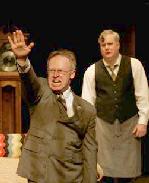SITE GUIDE
SEARCH
REVIEWS
FEATURES
NEWS
Etcetera and
Short Term Listings
LISTINGS
Broadway
Off-Broadway
NYC Restaurants
BOOKS and CDs
OTHER PLACES
Berkshires
London
California
DC
Philadelphia
Elsewhere
QUOTES
On TKTS
PLAYWRIGHTS' ALBUMS
LETTERS TO EDITOR
FILM
LINKS
MISCELLANEOUS
Free Updates
Masthead
A CurtainUp Review
The Good German
|
I have no desire to call attention to myself —Braun That alone would set you apart from your race.—Vogel |

Walker Jones and Brendan Patrick Burke in The Good German
|
The play, now having its New Jersey premiere, turns out to be quite an audacious consideration of the way we nurture hatred, embrace deceptions and lies, and give power to the many faces of racism, bigotry and prejudice. It is the closing months of World War II and the cozy wood-paneled living room of Karl and Gretel Vogelís home in southwest Germany is very inviting. Gretel (Jane Keitel), a nurse, has finished her shift at the hospital and brought along with her Braun (Brendan Patrick Burke), a frightened Jew and former book publisher whose wife and child were killed when their home was set afire by Nazi vandals. Gretel has no reason to believe that her husband Vogel (Paul Murphy), a chemist by profession and "a good German" by the generally acceptable standards, will not welcome him into their home. She convinces Braun, whom she passes off as her cousin, that he will be safe there.
Are we surprised that Vogel reveals himself as a stiff-necked autocratic and inhospitable prig who not only uses Braun as a target for an onslaught of condescending insults but relegates him to servitude as a butler and a cook. "I have no intention of eating kosher food," shouts the disdainful Vogel, who can barely keep from opening his mouth without making scorn-driven remarks about Jews, Gypsies and homosexuals.
Braun shows a dismaying willingness to kowtow to his hostís demeaning demands and tries his best not to make waves. He addresses Vogel as Herr Professor Doctor and takes great care not to reveal himself to Vogelís best friend Siemi (Walker Jones), a nervous and fidgety little man and constant visitor. Siemi, as portrayed by Jones with an increasing tendency for psycho-neurotic behavior, becomes a catalyst for the playís explosive and surprising climax. Tension quickly builds after Greta is shot and killed by the Gestapo. But humor also infiltrates the play as Braun slides with a smile into his duties as a domestic. He even slaps Vogelís hand for eating too many of his spaetzle (cookies). From his position as a desk clerk, Siemi rises quickly in the ranks of the Nazi party ("Everyone higher up has been killed"), and begins to suspect that his friend is harboring a Jew.
As Vogel, a burly, steely eyed Murphy looks formidable enough but unfortunately doesnít have the dramatic heft that could make his complex character come alive. Burke is splendid and pulls out all the emotional stops as the subservient definitely non-heroic Braun. Keitel is convincing in her small role as Gretel. But it is for Jones to provide the most indelible character, a probably closeted homosexual who is ordered to shoot homosexuals.
Under James Glossmanís direction the players often appear a trifle stiff and prone to posturing. The play, nevertheless, not only resounds with the fear of history repeating itself but also with impressively dimensional complex characters who fearlessly reveal their flaws but who also dare to stand up and question their stake in humanity.
The wood-paneled nicely furnished living including a piano (which is played) is the work of set designer Drew Francis. Especially noteworthy are the many obscure vintage music selections heard between scenes, the work of sound designer Jeff Knapp. This co-production between Playwrights Theater and Shadowland Theatre, Ellenville, N.Y. (where the play had its world premiere) is definitely worth seeing . It has what it takes to prompt some lively post curtain talks.
|
The Good German By David Wiltse Directed by James Glossman Cast: Brendan Patrick Burke, Walker Jones, Jane Keitel, Paul Murphy Set Design: Drew Francis Costume Design: Bettina Bierly Lighting Design: John Wade Sound Design: Jeff Knapp Running time: 2 hours including intermission Playwrights Theater, 33 Greenvillage Road, Madison, N.J. 973/514- 1787, ext. 30, www.ptnj.org Dates: October 5 — October 22, 2006 Thursday, Friday, Saturday at 8 PM, Sundays at 3 PM. Tickets:($25 - $35, $22.50 - $24.75, $15 for students Reviewed Simon† Saltzman based on performance October 8, 2006 |

Easy-on-the budget super gift for yourself and your musical loving friends. Tons of gorgeous pictures.

Leonard Maltin's 2007 Movie Guide

At This Theater
Leonard Maltin's 2005 Movie Guide

 >
>

